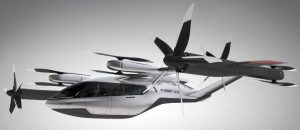Through its UAM platform, Hyundai plans to enable urban air travel with vehicles capable of electric vertical takeoff and landing (eVTOL), eliminating the need for runways. Safety provisions planned for the PAVs include multiple rotors to provide multi-layer redundancy and a parachute deployment system for emergencies. 
UAM will be made “affordable and accessible” the company claims, through the use of light-weight carbon composite materials, productive design technology and reduced operating costs. No pricing models have thus far been announced.
The firm also says its vehicles’ interiors will feature IoT functionality, although the specifics are similarly unclear at this time.
The concept PAV showcased at CES is called S-A1, and was developed with Uber. It’s designed to seat five people including a pilot, which Hyundai says will be required during “the early stages of commercialization,” however the firm aims to enable autonomous operation at a future date.
The introduction of personal air travel is promised to ease the effects of mega-urbanization, improving transfer efficiency for city areas and reducing gridlock.
Eric Allison, head of Uber Elevate, says “Combining Hyundai’s manufacturing muscle with Uber’s technology platform represents a giant leap forward for launching a vibrant air taxi network in coming years.”
The company’s UAM plans form part of an ambitiously transformative vision for urban mobility.
Other concepts include the aforementioned PBVs and the “Hub”. The ground-based PBVs, inspired by the San Francisco cable car, appear to marry public transport with services and social spaces. Hyundai suggests one could function as “a restaurant, coffee shop, and hotel, or even a clinic and pharmacy, in addition to being an urban shuttle”.
The vehicles are planned to comprise of modular segments which can be assembled and reassembled, and will use both AI navigation and electric battery power, Hyundai claims.
Connecting the two types of vehicle is the Hub, which features multiple docking stages for PBVs and a skyport for PAVs on the roof. Through the docking of specific PBVs around a Hub, Hyundai suggests individual units could become cultural or medical complexes.
As of now, no timescale has been announced for the availability of any of the services described.
 Electronics Weekly Electronics Design & Components Tech News
Electronics Weekly Electronics Design & Components Tech News



